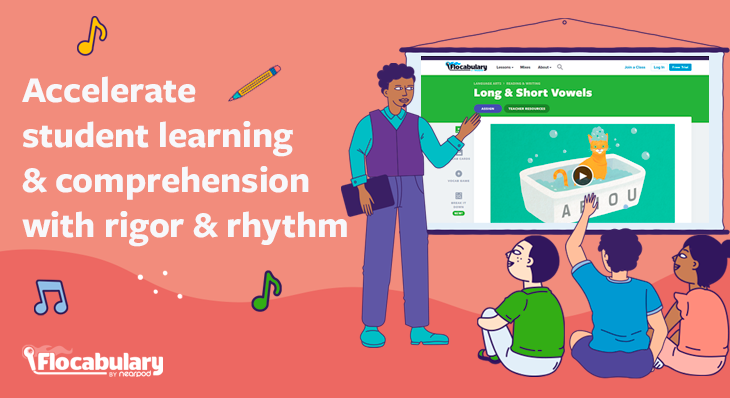
Accelerate comprehension skills with rigor and rhythm in education
Is anyone guilty of not seeing how something that’s fun can also be a genuine learning experience? School is obviously about learning, and educators continuously seek ways to accelerate learning and comprehension while supplying rigor in education through resources and strategies they use.
However, when students appear to be having fun while learning, these activities can often, and unfortunately, be mislabeled as lacking rigor. But make no mistake about it—learning should be fun.
As a young school administrator, I often walked into classrooms to observe what my teachers did with their students. Seeing the teacher at the front of a class with students quietly working in silos gives the standard assumption that serious learning is taking place, but that wasn’t usually the case.
What is rigor in education?
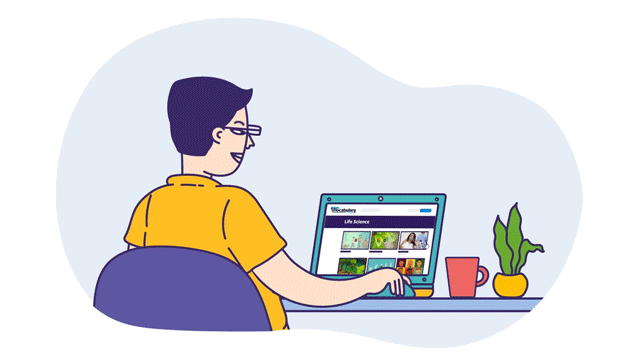
The Glossary of Education Reform defines academically rigorous instruction as a scenario where educational expectations are academically, intellectually, and personally challenging. School administrators seek this in the lessons their teachers prepare to help students achieve mastery of the content they’re learning.
Can rigor and fun coexist in education?
The inclination of children to laugh and shout out their responses to the teacher’s questions while constantly moving about the room seemed more chaotic than anything. Some (Kent, 2016) have even gone as far as to say that learning comes first, and it is through that discovery students actually find fun and enjoyment in their education. I would like to challenge that notion.
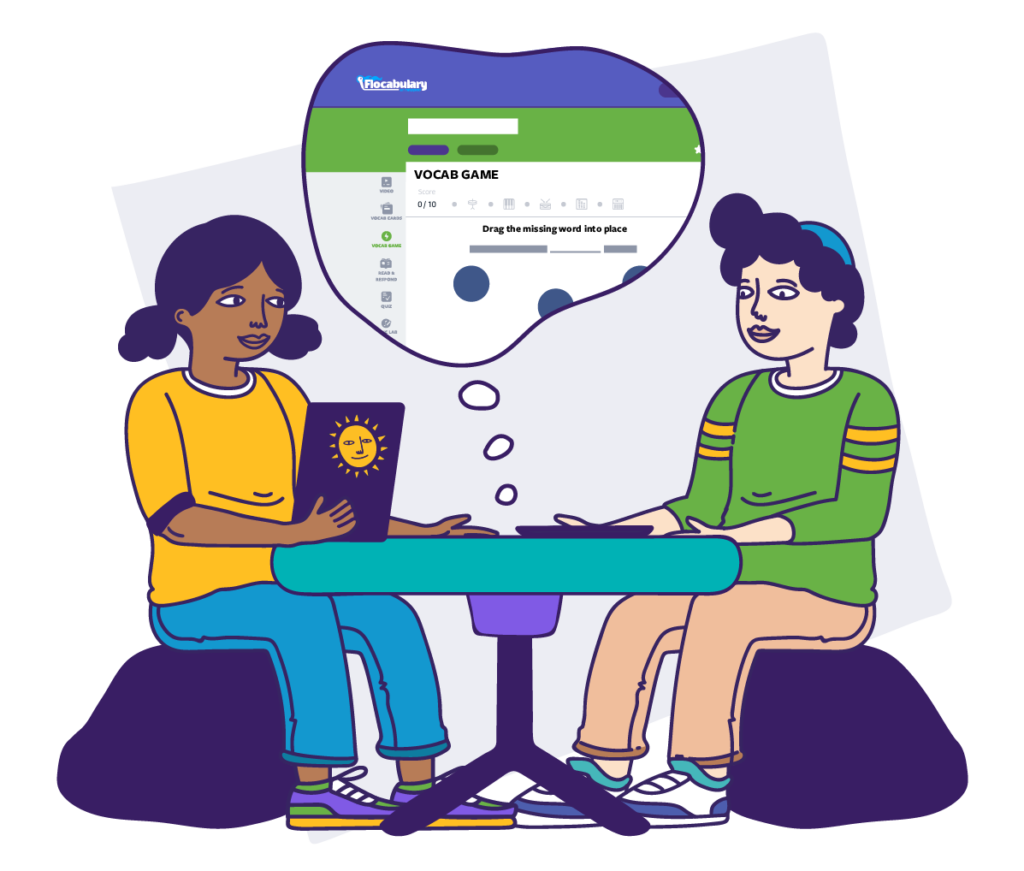
During my tenure as a school administrator, I watched teachers pour their hearts and soul into creating lessons that hit every learning objective required to teach in a particular unit, only to fail miserably when executing it. In many cases, they were missing just one thing: fun. Fun can lead to engagement, and engagement can lead to a deeper level of learning. The LEGO Foundation’s white paper about Learning Through Play stated: “Learning through play also involves being actively engaged. When children are immersed in the act of self-directed effort, are minds-on, and persist through distraction, we see benefits to learning.”
When accelerating comprehension skills with rigor and rhythm using Flocabulary, it’s important to understand what is rigor in the classroom. With this engagement comes comprehension strategies, and all three combined often lead to a rigorous learning experience for students. Shukla (2020) stated, “Fun and play in classroom learning reduce the rigidity of the curriculum, which allows more student autonomy. It gives a sense of control to the students. People have an innate need for growth (self-determination theory), which comes easily if there is autonomy, relatability, and a sense of competence. Fun and play allow a student to maximize all 3.” Ultimately, the argument here is unambiguous: fun and rigor in education can coexist.
How to accelerate learning and comprehension skills through rigor and rhythm
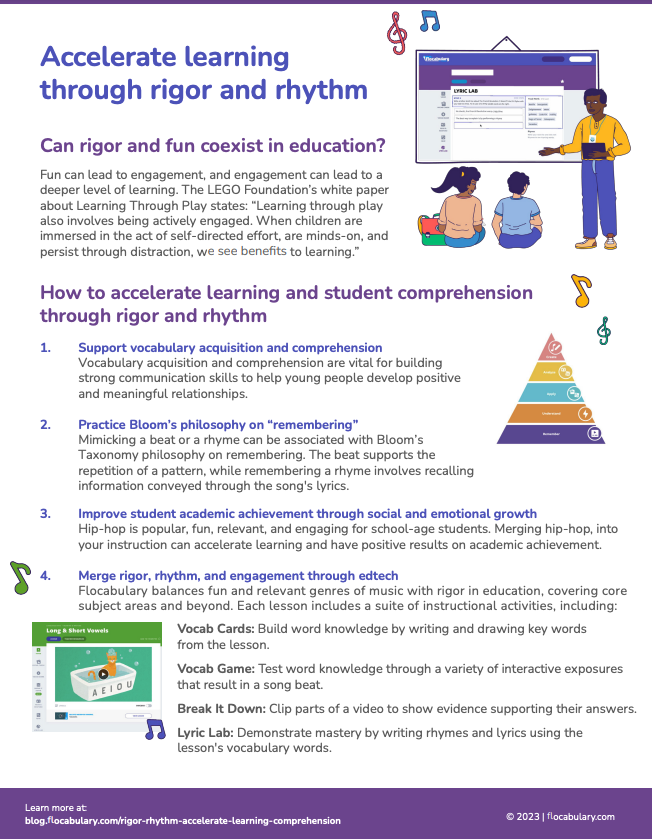
There are numerous ways to incorporate fun and rigor in learning across all subject areas. We at Flocabulary recognize the fun to be found in rhythm as one of them. This is particularly true when taking literacy into account. While the broad concept of rhythm might cover an array of things, we approach rhythm as a musical descriptor.
For many of us, listening to music instantly taps into how we feel. Often, music induces that feel-good type of euphoria inside us. Basically, music can be fun. The rhythm in music is linked to language and literacy.
If you’re interested in downloading a one-pager summarizing how to accelerate rigor and rhythm through Flocabulary, click below!
Flocabulary, a K-12 digital and video-based hip-hop learning platform, brings engagement and rigor to the forefront for accelerating learning. Using Flocabulary, comprehension skills, and vocabulary acquisition are delivered via a rigorous curriculum wrapped in an array of comprehension strategies offering flexible options to deepen student learning.
For example, Goodger (2022) stated songs that were coordinated through the use of intoned language and expressive gestures, when applied to learning, resulted in what was called “PMA” (Permanent Memory Acquisition). Generally speaking, the idea that music is conducive to learning is nothing new. A John Hopkin’s study referenced earlier literature (Brewer, 1995), which points to using background music as a cornerstone to accelerate learning.
1. Support vocabulary acquisition and comprehension
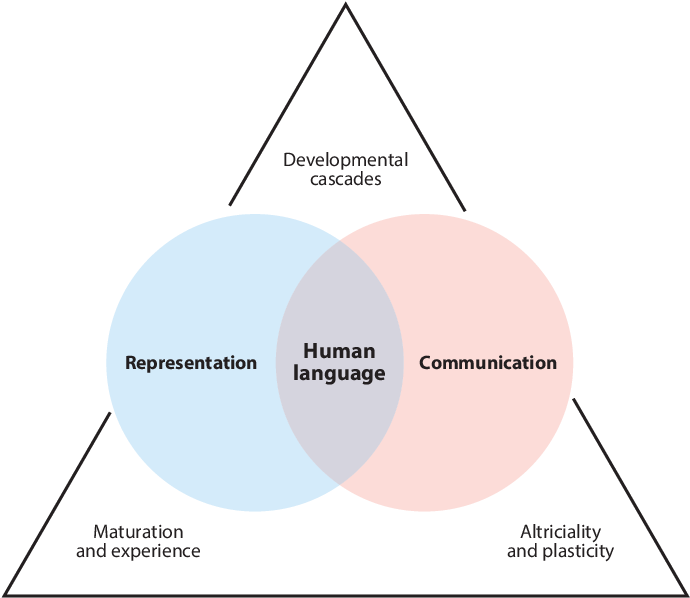
We often equate having good rhythmic skills to dancing, but it’s also been proven to enhance our language and communication skills. Vocabulary acquisition and comprehension are vital for developing strong communication skills to help young people develop positive and meaningful relationships. One study (Lau et al., 2022) stated, “Thus, the power of rhythm is clear: Rhythm supports language acquisition from the start and continues to support language processing into adulthood.” The various musical elements of rhythm begin with simply drumming to a beat and mimicking rhymes, to actually creating them. The benefits of each of these processes are essential to learning and rigor in education.
2. Practice Bloom’s philosophy on “remembering”
Mimicking a beat or a rhyme can be associated with Bloom’s Taxonomy philosophy on remembering. The beat supports remembering and repeating a pattern while remembering a rhyme involves recalling the information conveyed through the song’s lyrics. But what does rigor look like in the classroom when these concepts are applied? Taking the same two ideas from a more creative approach allows learning to occur at the highest level of Bloom’s—creating—while engaging students in rigorous tasks that challenge them to synthesize and produce new ideas from the material they’ve learned.
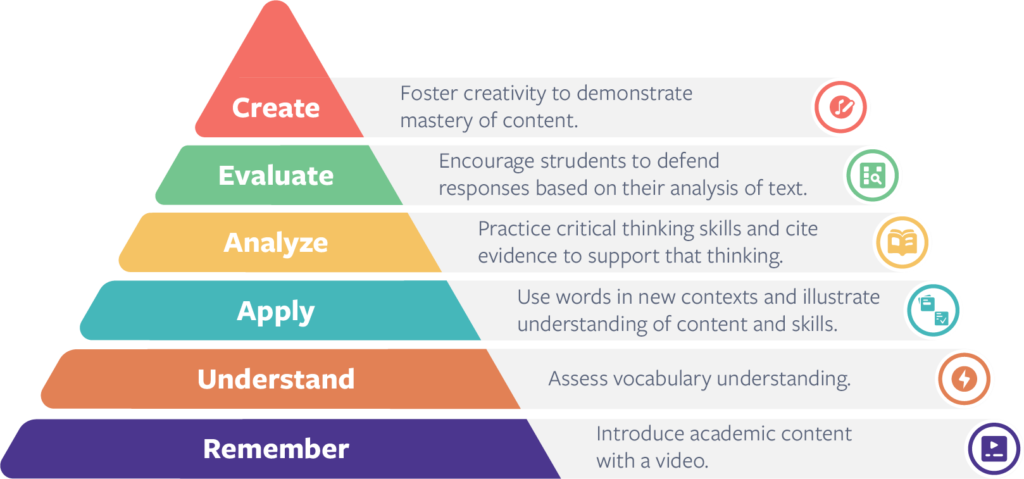
Creating a beat requires reorganizing sound elements to produce a new pattern. Creating a rhyme requires students to use the knowledge obtained and information remembered during instruction to work towards the second level of Bloom’s and show their comprehension of concepts. Ultimately students create their rhymes, putting them at the highest level of Bloom’s Taxonomy for higher-order thinking.
3. Social and emotional growth leads to student academic achievement
Beat and rhyme-making are two major components of hip-hop music. Hip-hop has been the number one genre of music in the world, regardless of language or location. It is also fun, relevant, and engaging for school-age students. Now, imagine merging the most popular genre of music, hip hop, into your instruction. The impact of students using hip-hop to accelerate learning has had positive results on academic achievement. These benefits have also been attributed to positively impacting students’ social and emotional growth.
A study (Travis et al., 2019) suggested that “a well-designed, research-based hip hop-integrated strategy may complement summer learning strategies and help improve mental health outcomes for low-income middle school youth. It is necessary to continue research that explores the efficacy of hip hop-based mental health interventions and potential ways to mitigate social and emotional loss alongside an academic loss in the summer months.”
Watch the video below to see how Flocabulary teaches social and emotional learning topics through hip-hop music.
4. Merging rigor, rhythm, and engagement through edtech
School administrators are seeking a balance. Most recognize the benefits of having a classroom filled with engaged learners digesting a well-planned lesson. The key is bringing the reluctant learner along with everyone else in the process. This is just what Hinton (2020) discussed when researching how schools used hip-hop music to ignite student learning and creativity.
Other research studies, like the one by Jones (2022), have determined that students can advance their English skills by analyzing, annotating, and researching through hip hop. These skills are key to comprehension and fall among the higher category tier of Bloom’s Taxonomy. This approach ensures that students work at higher levels and tackle content that challenges students beyond their comfort zones. By integrating rhythm through music and engaging videos, Flocabulary enhances the learning process, helping students learn at high levels.
How Flocabulary balances engagement and rigor in education to accelerate learning
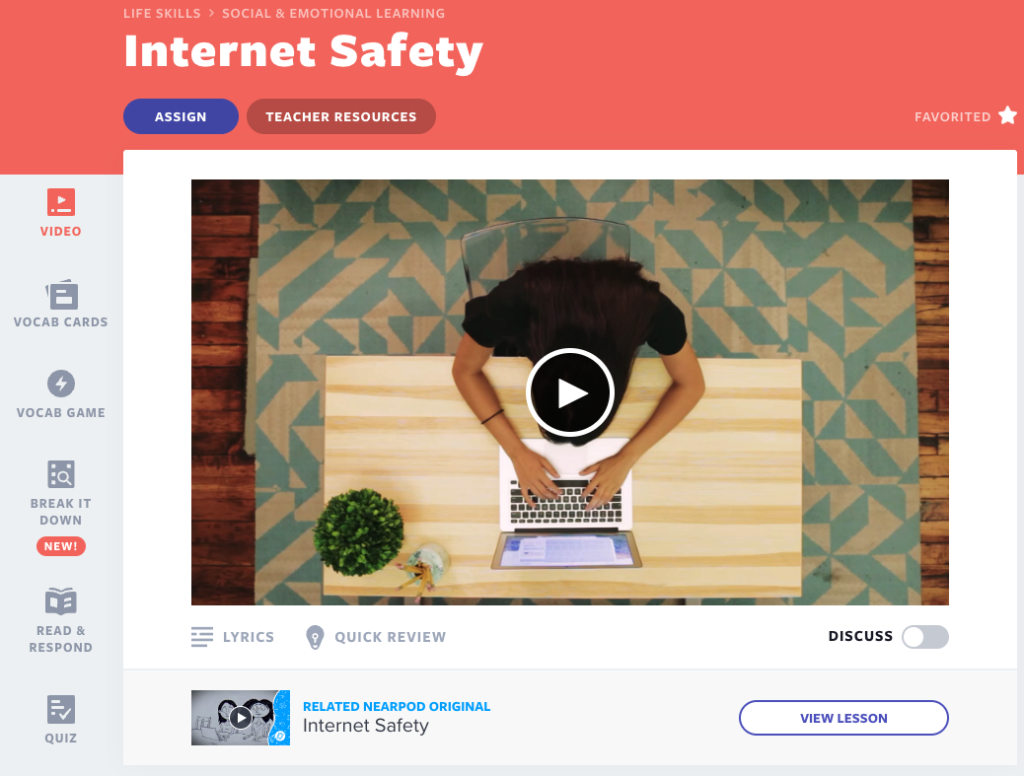
Flocabulary has K-12 standard-aligned video-based lessons and activities that leverage the power of hip-hop, storytelling, and emotional connections to cultivate literacy across the curriculum. It has proven to strengthen students’ understanding and highly engage them, ultimately leading to improved learner outcomes.
Flocabulary aligns with Bloom’s Taxonomy in its sequence of activities and empowers educators to deliver that balance of fun and rigor that is authentically engaging. The lesson sequence provides flexible options to accelerate learning and deepen comprehension skills through multiple exposures to subject-specific content.
There are many methods to help teachers incorporate music and rhythm into their classrooms and tutoring programs. Components of rhythm can be seen throughout Flocabulary’s sequence of activities. Initially, students can watch and sing along with a Flocabulary original hip-hop music video. These are meant to hook students using fun and catchy tunes and let them identify with the people they see represented in the videos.
Ultimately Flocabulary succeeds by balancing a fun and relevant genre of music with rigor in education covering core subject areas and beyond.
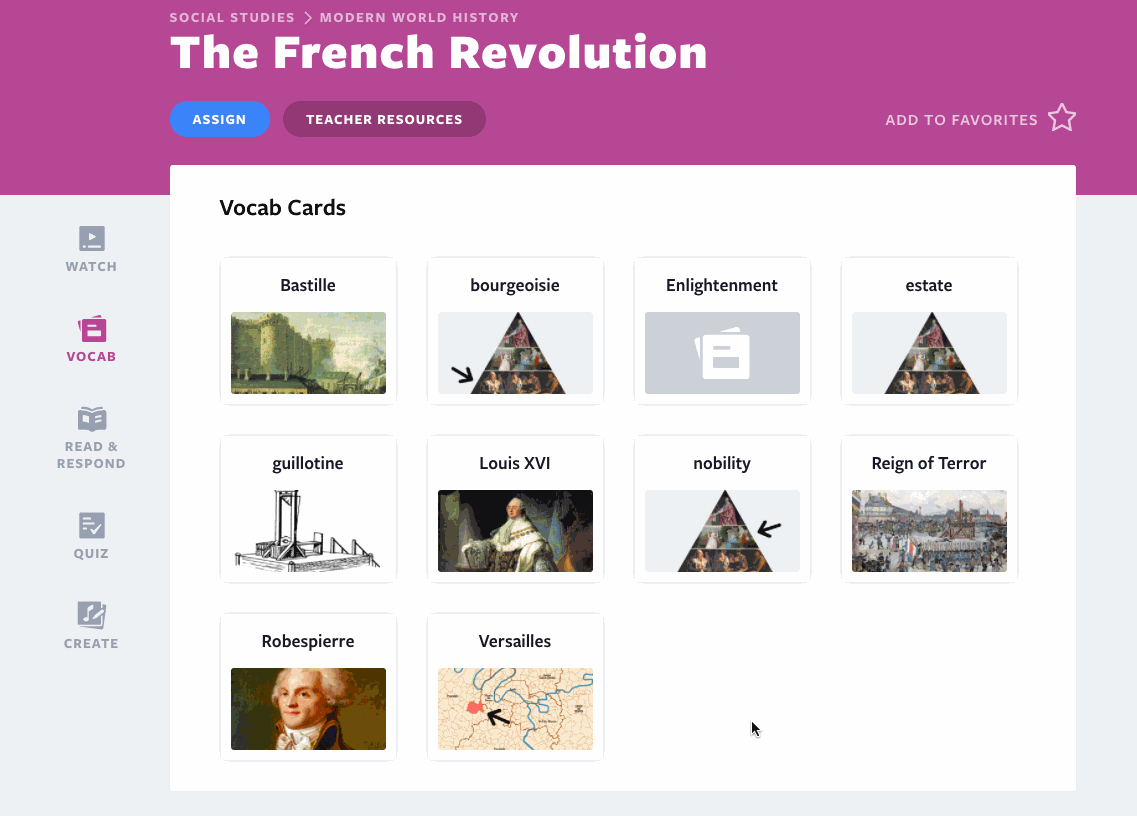
Vocab Cards
After viewing the video, there’s a suite of instructional activities available. For example, the Vocab Card activity. This activity allows students to make meaning of new vocabulary words through writing and drawing opportunities provided with each card in that lesson. The cards include a definition, sentence use, part of speech for the word, and a visual representation.
Break it Down
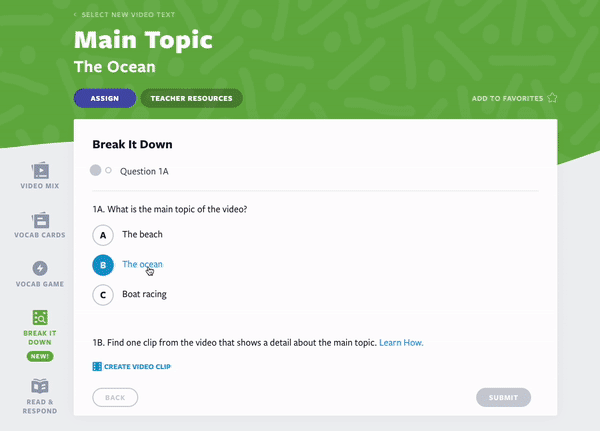
Flocabulary’s Break It Down creates additional exposures to vocabulary words through a short series of connected tasks. These tasks start with a multiple-choice question that supports text analysis. The second task is to clip a video to show evidence in support of the previous answer and the final task is an open-ended question to challenge students to justify their evidence.
Vocab Game
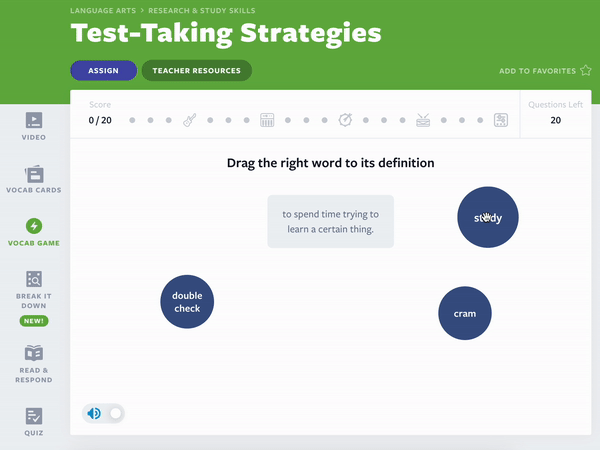
A gamified instructional activity in Flocabulary is the Vocab Game to accelerate learning. Students select the correct answer and drag them into the box or over the correct definition. Each correct answer moves a student closer to earning an additional instrument that is added to the beat. Once students accurately complete the set of questions, they gain access to the full instrumental beat. By strategically incorporating prior knowledge and background information, students work in small groups to tackle reading comprehension challenges.
In a small group setting, teachers can support students in improving reading comprehension and vocabulary by reading aloud and discussing unfamiliar words through this activity, while building background knowledge to boost understanding.
Lyric Lab
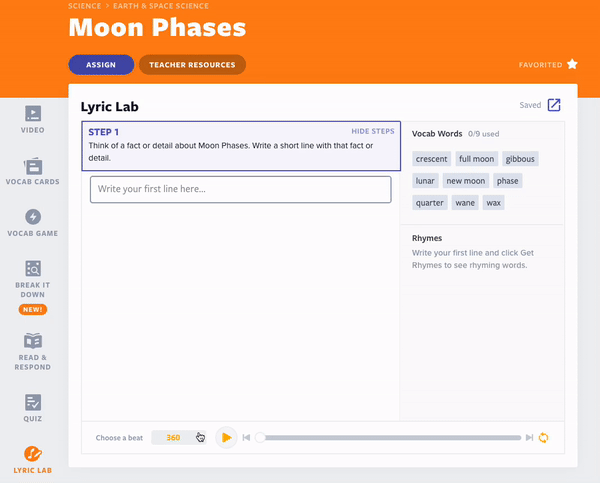
The final activity for any lesson is the Lyric Lab. This encourages students as they create their own rhymes or poems using key vocabulary terms from the lesson. Using Lyric Lab, students are no longer consumers of content but rather creators of content themselves, which is an example of rigor in education. Students write a line for their rap using the vocabulary word bank, and then the rap generator offers additional words they can use in the next line. Students can also select a unique beat to go with their rap. This is a great tool for formative assessment for increasing rigor. Lyric Lab is both challenging and fun for students, and they love it!
Accelerate learning in your school or district with Flocabulary’s support
Overall, Flocabulary’s content is witty and features diverse representation, while the platform is easy to use. Rigor challenges students by incorporating grade-level content while pushing them to engage in learning activities that develop critical thinking. Examples of rigor in the classroom include interactive discussions, questioning strategies, and assignments that increase the level of rigor for deeper comprehension. Once administrators and teachers see engaged students learning with Flocabulary, it’s easy to see why we wholeheartedly believe that Flocabulary is definitely where rhythm meets rigor. Whether you teach elementary, middle, or high school, it’s important to prioritize supporting rigorous development of reading comprehension skills through explicit instruction. By providing targeted guidance and structured learning experiences, students are empowered to learn at a high level and improve comprehension skills.
Want to learn more about bringing Flocabulary’s authentically engaging experiences to your school or district?
